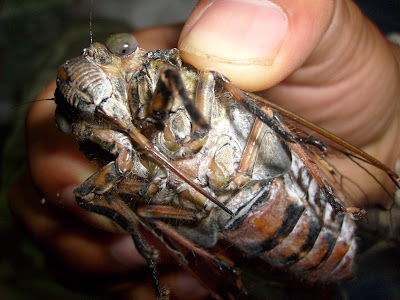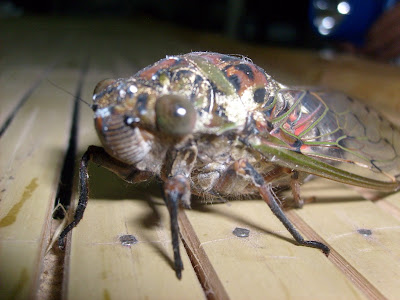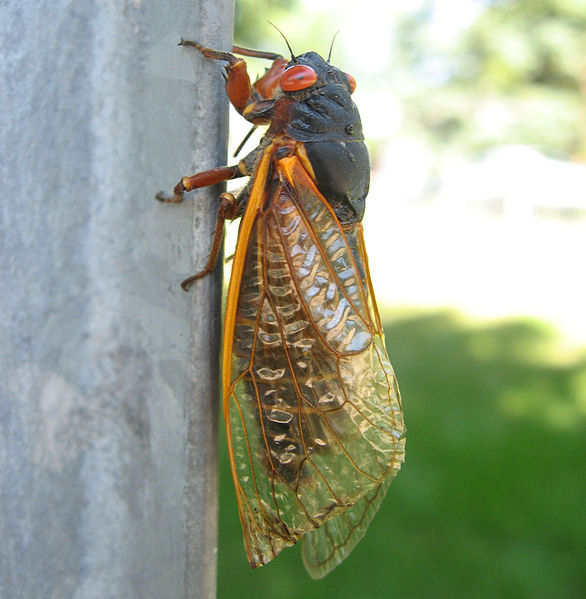 Cicada Books
Cicada Books





 Cicada Books
Cicada BooksFrom Wikipedia, the free encyclopedi
A cicada (pronounced /sɪˈkeɪdə/) is an insect of the order Hemiptera, suborder Auchenorrhyncha, in the superfamily Cicadoidea, with large eyes wide apart on the head and usually transparent, well-veined wings. There are about 2,500 species of cicada around the world, and many remain unclassified. Cicadas live in temperate to tropical climates where they are among the most widely recognized of all insects, mainly due to their large size and remarkable acoustic talents. Cicadas are sometimes colloquially called "locusts",[1] although they are unrelated to true locusts, which are a kind of grasshopper. They are also known as "jar flies". Cicadas are related to leafhoppers and spittlebugs. In parts of the southern Appalachian Mountains in the United States they are known as "dry flies" because of the dry shell they leave behind.
Cicadas are benign to humans and do not bite or sting, but can be pests to several cultivated crops. Many people around the world regularly eat cicadas: the female is prized as it is meatier. Cicadas have been (or are still) eaten in Ancient Greece, China, Malaysia, Burma, Latin America, and the Congo. Shells of cicadas are employed in the traditional medicines of China.[2]
The name is a direct derivation of the Latin cicada, meaning "buzzer". In classical Greek it was called a tettix, and in modern Greek tzitzikas - both names being onomatopoeic
Cicadas are benign to humans and do not bite or sting, but can be pests to several cultivated crops. Many people around the world regularly eat cicadas: the female is prized as it is meatier. Cicadas have been (or are still) eaten in Ancient Greece, China, Malaysia, Burma, Latin America, and the Congo. Shells of cicadas are employed in the traditional medicines of China.[2]
The name is a direct derivation of the Latin cicada, meaning "buzzer". In classical Greek it was called a tettix, and in modern Greek tzitzikas - both names being onomatopoeic
Taxonomy
Cicadas are arranged into two families: Tettigarctidae (q.v.) and Cicadidae. There are two extant species of Tettigarctidae, one in southern Australia, and the other in Tasmania. The family Cicadidae is subdivided into the subfamilies Tettigadinae, Cicadinae, and Cicadettinae, and they exist on all continents except Antarctica.
17-year cicada, or magicicada
Cicada found in Chicago, IL, USA, on June, 2007
The largest cicadas are in the genera Pomponia and Tacua. There are some 200 species in 38 genera in Australia, about 450 in Africa, about 100 in the Palaearctic, and exactly one species in England, the New Forest cicada, Melampsalta montana, widely distributed throughout Europe. There are about 150 species in South Africa.
Most of the North American species are in the genus Tibicen - the annual or dog-day cicadas (so named because they emerge in late July and August [1] ). The best-known North American genus is Magicicada, however. These periodical cicadas have an extremely long life cycle of 13 to 17 years and emerge in large numbers.[1] Another American species is the Apache cicada, Diceroprocta apache.
Australian cicadas can differ from many other types because of that continent's diversity of climate and terrain. In Australia, cicadas are found on tropical islands and cold coastal beaches around Tasmania; in tropical wetlands; high and low deserts; alpine areas of New South Wales and Victoria; large cities like Sydney, Melbourne, and Brisbane; and Tasmanian highlands and snowfields.
Thirty-eight species from five genera populate New Zealand, and all are endemic to New Zealand and the surrounding islands (Norfolk Island, New Caledonia). Many New Zealand cicada species differ from those of other countries by being found high up on mountain tops.
Cicadas are arranged into two families: Tettigarctidae (q.v.) and Cicadidae. There are two extant species of Tettigarctidae, one in southern Australia, and the other in Tasmania. The family Cicadidae is subdivided into the subfamilies Tettigadinae, Cicadinae, and Cicadettinae, and they exist on all continents except Antarctica.
17-year cicada, or magicicada
Cicada found in Chicago, IL, USA, on June, 2007
The largest cicadas are in the genera Pomponia and Tacua. There are some 200 species in 38 genera in Australia, about 450 in Africa, about 100 in the Palaearctic, and exactly one species in England, the New Forest cicada, Melampsalta montana, widely distributed throughout Europe. There are about 150 species in South Africa.
Most of the North American species are in the genus Tibicen - the annual or dog-day cicadas (so named because they emerge in late July and August [1] ). The best-known North American genus is Magicicada, however. These periodical cicadas have an extremely long life cycle of 13 to 17 years and emerge in large numbers.[1] Another American species is the Apache cicada, Diceroprocta apache.
Australian cicadas can differ from many other types because of that continent's diversity of climate and terrain. In Australia, cicadas are found on tropical islands and cold coastal beaches around Tasmania; in tropical wetlands; high and low deserts; alpine areas of New South Wales and Victoria; large cities like Sydney, Melbourne, and Brisbane; and Tasmanian highlands and snowfields.
Thirty-eight species from five genera populate New Zealand, and all are endemic to New Zealand and the surrounding islands (Norfolk Island, New Caledonia). Many New Zealand cicada species differ from those of other countries by being found high up on mountain tops.
Description
The adult insect, sometimes called an imago, is usually 2 to 5 cm (1 to 2 in) long, although some tropical species can reach 15 cm (6 in), e.g. Pomponia imperatoria from Malaysia. Cicadas have prominent eyes set wide apart on the sides of the head, short antennae protruding between or in front of the eyes, and membranous front wings. Also, commonly overlooked, cicadas have 3 small eyes located on the top of the head between the two large eyes that match the color of the large eyes, giving them a total of five eyes. Desert cicadas are also among the few insects known to cool themselves by sweating,[3] while many other cicadas can voluntarily raise their body temperatures as much as 22 °C (72 °F) above ambient temperature.[4]
The adult insect, sometimes called an imago, is usually 2 to 5 cm (1 to 2 in) long, although some tropical species can reach 15 cm (6 in), e.g. Pomponia imperatoria from Malaysia. Cicadas have prominent eyes set wide apart on the sides of the head, short antennae protruding between or in front of the eyes, and membranous front wings. Also, commonly overlooked, cicadas have 3 small eyes located on the top of the head between the two large eyes that match the color of the large eyes, giving them a total of five eyes. Desert cicadas are also among the few insects known to cool themselves by sweating,[3] while many other cicadas can voluntarily raise their body temperatures as much as 22 °C (72 °F) above ambient temperature.[4]

Cicada found in Chicago, IL, USA, on June, 2007
Kingdom:Animalia
Phylum:Arthropoda
Class:Insecta
Order:Hemiptera
Suborder:Auchenorrhyncha
Infraorder:Cicadomorpha
Superfamily:Cicadoidea
Family:Cicadida
Class:Insecta
Order:Hemiptera
Suborder:Auchenorrhyncha
Infraorder:Cicadomorpha
Superfamily:Cicadoidea
Family:Cicadida



Cicada found in Lampang,Th,on June 2009
Cicada Books
http://astore.amazon.com/home-and-garden-store-online-20
http://astore.amazon.com/hydrofarm-system-garden-20
http://astore.amazon.com/playhouse-disney-20
http://astore.amazon.com/shop-electronics-department-20
http://astore.amazon.com/solar.garden.lights-20
http://astore.amazon.com/swimming-pool-equipment-20
http://astore.amazon.com/wind-turbine-generator-20
No comments:
Post a Comment